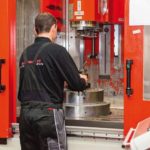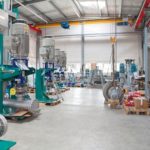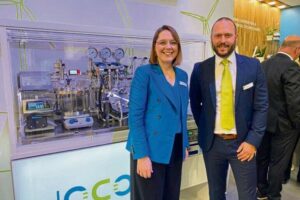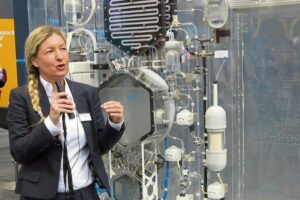What special features need to be taken into consideration when pumping toxic, potentially explosive or boiling liquids?
Frank Bungartz: For potentially explosive mixtures – and when ignition sources are present – the explosion prevention directives
of the EU need to be taken into account (Atex 1014/34/EU). Different protection categories apply to centrifugal pumps.
Pumps that, for example, are designed to be immersed in a vessel with a zone 0 atmosphere are required to conform to category 1.
In an Atex zone 0, where a frequently or continuously explosive mixture is present, this means that pumps are not permitted to produce any ignition sources. Not even in the case of extremely rare faults, because safety has the highest priority.
In a hazardous and potentially explosive atmosphere with mixtures of air, flammable gases, vapours or mists, the danger to personnel and the environment must be excluded to the greatest extent possible.
Why are standard submersed column pumps not suitable for these application areas?
Bungartz: A distinction needs to be made between submersed column pumps and submersible motor pumps. With the former, the pump hydraulics are submerged in the pumping liquid. With submersible motor pumps, not only the hydraulic components but also the motor are submerged in the pumped medium. Standard submersed column pumps are fitted with product-lubricated slide bearings. They are just as unsuitable for zone 0 as pumps with double mechanical seals. Neither is safe to run dry, because their slide bearings are flushed by external water or by the medium. In zone 0, increased bearing temperatures during the start-up phase can be dangerous. A potential level control failure would also be hazardous. Additional control units can provide a warning of the problems, but the result will always be an interruption in pumping. That costs time and money.
What differences are there with the submersed column pumps used by Bungartz?
Bungartz: All of our pumps, including the submersed column pumps, are designed on a requirement-specific basis and manufactured to order using series-produced components. All of them are continuously safe to run dry with a high degree of intrinsic safety, and some can pump without cavitation. Instead of using sensitive mechanical seals as the primary seal, we build units such as the submersed column pump MPCTAN with a dry-running magnetic drive. The vertical design of the pump is already an advantage. This prevents the seal and the lifetime-lubricated bearing from coming into contact with the pumping medium, even in the event of sealing gas failure. A major component here is our threefold seal: the sophisticated design of the shaft gap concept consists of a hermetic sealing. This is achieved on the atmosphere side by the permanently dry-running, vortex-free magnetic drive (through a ceramic containment cup), which, as I say, is not in contact with the pumping liquid or its gases. A secondary seal such as a gas-lubricated lip seal can then be used. The pumping medium is beforehand pumped away from the shaft seal by the blades on the rear of the impeller. The blading counteracts the feed and pumping pressure with a greater pressure. This hydrodynamic seal ensures that the secondary seal is never in contact with the product. Furthermore, gas barriers (sealing gas) protect the bearing unit against the penetration of product vapours. The bearing and sealing unit thus remain without contact to the product or pumping liquid or to their gases, and are thus permanently dry. Even if a malfunction were to occur with the bearing or individual sealing components, vapours or liquids could therefore never escape. In addition to this, we utilise self-regulating behaviour for this type of pump, too.
What is the self-regulating behaviour about?
Bungartz: As with all pumps in the V-AN series, the self-regulating behaviour ensures that the MPATAN adapts to changing feed rates. This type of pump does not use suction, but automatically regulates its speed to the feed flow of medium (similar mode of action to a siphon). Fluctuating feed rates, sporadic use, and in particular the total emptying of tanker trucks and tank wagons are therefore amongst their specialties. The monitoring systems required by the Atex Directive can be relocated from the Atex zone 0 atmosphere to a lower Atex zone. When installed outside the sump, the typical monitoring costs are significantly reduced.
What types of application exist in practice?
Bungartz: The options are numerous. Our pumps are used all over the world – including our submersed column pumps. Frequent applications can be found in the field of refinery waste tanks. The special feature here is that the monitoring systems required are limited to the sealing gas monitoring system. These are installed outside the pit, and thus not within the Atex zone 0 atmosphere. Our submersed column pumps are in demand wherever the aforementioned challenging media are handled. Fluctuating feed rates and sporadic use are tasks that our pumps master effortlessly.
Bungartz continues to develop its pumps further. What can we expect to see in the future?
Bungartz: Yes, the MPCTAN with its gas-sealed lip seal is a further development of the MPATAN, which was fitted with a gas-lubricated single mechanical seal. With an immersion depth of up to 5.5 m and capable of conveying media up to temperatures of 280 °C, the MPCTAN can be used in Atex zone 0/1 or 2 for boiling and/or toxic media containing gaseous and solid components. We are in the process of modifying the design of this pump type to also enable its use in high-temperature applications such as those encountered in salt melts.
What sort of cost-benefit ratio does this pump type offer?
Bungartz: Like all our pumps, our submersed column pumps reduce the plant engineering costs through their favourable infrastructure. This means lower planning costs, and the reduced need for signalling and components also has a positive impact on life cycle costs. Additionally, availability is increased because there are fewer sources of faults – safety from operator error is also a major point. Unplanned plant stoppages are thus a thing of the past.
Paul Bungartz GmbH & Co KG, Düsseldorf
“The MPATAN ensures absolutely trouble-free operation in hazardous environments. Operators report service lives of over 10 years – without any malfunctions or maintenance at all.”











